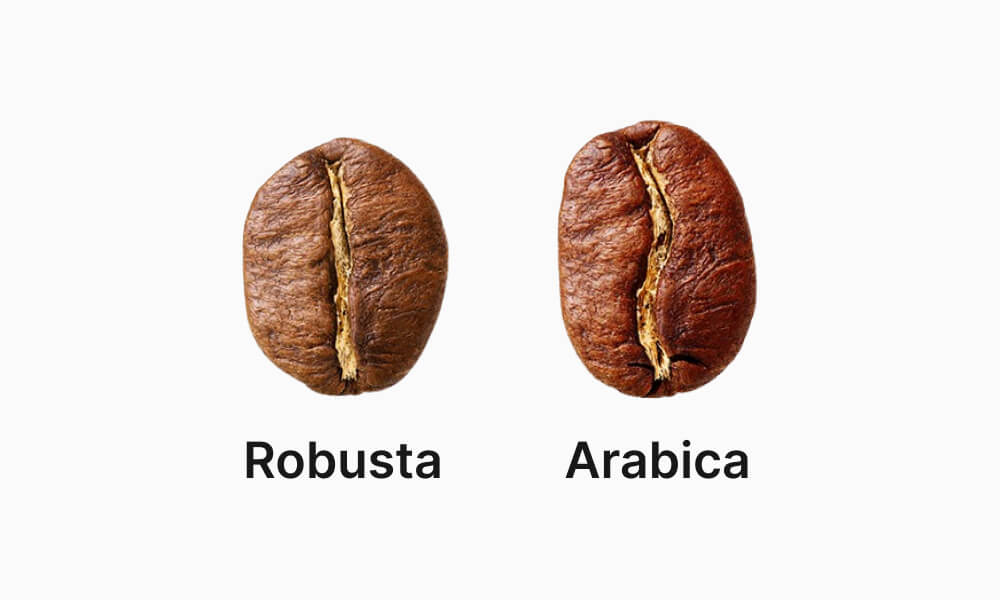Robusta vs Arabica
Arabica and Robusta are the two types of coffee grown on an industrial scale. There are others, but their quantities do not exceed two percent of the world’s coffee. For example, Liberica, Excelsa and Eugenioidis.

Arabica beans have a more elongated shape than Robusta
Of the total production of Arabica and Robusta, Arabica accounts for about 70 percent and Robusta for 30 percent. There are many reasons for Arabica’s popularity. The most important is that Arabica simply tastes better. But interestingly, the two plants are related. To be more precise, Arabica was created by crossing Robusta and Eugenioidis.
Eugenioidis is a very rare type of coffee that grows on small shrubs. Its beans are very small, and its yield is low, so it cannot be grown on a large scale. This coffee has a very low caffeine content – only 0.2%. Therefore, Arabica has less caffeine than Robusta.
Arabica and Robusta look different, grow differently, and differ greatly in taste and price. Let’s break down the key differences between the two.
Growing conditions
Arabica is very demanding and grows at altitudes from 600 to 2000 meters and sometimes even higher. Arabica is expensive and difficult to cultivate. It is susceptible to disease, and to obtain a good harvest, the trees must be constantly tended, the soil fertilized and, in some regions, artificial irrigation systems built.
It is important for Robusta to be warm. That’s why it only grows in tropical climates. But everything else is secondary. Robusta can grow on the plains and in the mountains. It can easily withstand heat and heavy rains, it doesn’t get sick and it doesn’t need much care.
Just for comparison: Brazil, the champion coffee producer, grew ≈ 2,080,000 tons of Arabica in 2011 (total production was 2.7 million tons). And Vietnam, in second place, grew ≈ 660,000 tons of Robusta in the same year. Yes, that’s three times less than Brazil. But at the same time, the total area of Vietnam is five times smaller than Brazil’s coffee plantations.
Flavor
Arabica is rich in lipids, which make the flavor intense and acidic. In a particular variety of Arabica from a particular region, you can taste the sweetness of berries, the acidity of citrus, and the aroma of flowers and nuts.
Robusta has more caffeine and chlorogenic acid and less lipids and sugars. This makes Robusta a good energy booster, but the caffeine also gives the coffee a bitterness and heavy taste. Robusta’s taste is astringent and flat. It doesn’t have the same nuances as Arabica.
The flavor is highly dependent on the care the coffee receives on the farm. Just because Robusta is unpretentious does not mean it does not need care. A good Robusta that is watched and cared for will be better than an Arabica that is neglected.
And don’t drink instant coffee. Despite what the manufacturers say, it is almost always made from cheap Robusta. Although it is sometimes made from good Arabica, the truth is that it is quite expensive.
Price
Obviously, Arabica is more expensive. Because it grows only in the mountains, it is more difficult to grow, transport and process. This includes the cost of fertilizers and irrigation. In a bad year, Arabica can easily get sick and the surviving crop will be expensive.

Average Global Arabica and Robusta Coffee Prices from 2014 to 2025* (* – Forecasts) / Statista
Robusta doesn’t need height, doesn’t suffer from rain and heat, and can easily resist disease. Robusta trees are three to four times larger than Arabica, growing up to 13 meters, and the yield is much higher. All this reduces the cost of producing Robusta, making it much cheaper than Arabica.
In order to reduce production costs, low and medium volume coffee shops often use a blend of Arabica and Robusta. This saves a lot of beans, but does not completely ruin the taste of the drink.
Why is Robusta so taboo?
Arabica and Robusta have their own uses and their own fans. There is no consensus as to which is better or worse. Some people think that Robusta should not be used at all. And someone is doing a lot of research to find a variety of Robusta that will open up new flavors together with Arabica.
Robusta gives good cream in espresso, density and longevity of the drink. But the taste has an unpleasant bitterness and heavy aroma. That doesn’t mean you can’t make something good with Robusta.
Classic Italian coffee is almost always a heavily roasted blend of Arabica and Robusta. Such blends are cheaper than pure Arabica and give the coffee its characteristic bitterness. Cappuccino made from such a blend has interesting chocolate notes, and some people prefer this type of coffee.
Preparing Robusta in other ways is not the best idea. If you prepare coffee in a French press, pour-over or any other way, it is better to use Arabica.
It’s important to remember one rule: you can always find something good in coffee that’s been carefully cared for. Bad coffee is not Arabica or Robusta. Bad coffee is coffee that has not been cared for.